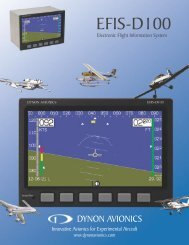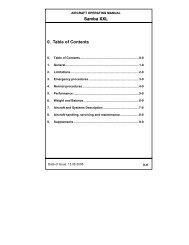UFM-13 â 2/2009 - Advanced Composite Aircraft
UFM-13 â 2/2009 - Advanced Composite Aircraft
UFM-13 â 2/2009 - Advanced Composite Aircraft
Create successful ePaper yourself
Turn your PDF publications into a flip-book with our unique Google optimized e-Paper software.
Mandatory bulletin <strong>UFM</strong>-<strong>13</strong> - 2/<strong>2009</strong>, <strong>UFM</strong>-11 – 1/<strong>2009</strong><br />
MANDATORY BULLETIN<br />
Number: <strong>UFM</strong>-<strong>13</strong> – 2/<strong>2009</strong><br />
<strong>UFM</strong>-11 – 1/<strong>2009</strong><br />
Date of issue: 17.8.<strong>2009</strong><br />
Applicable for <strong>UFM</strong>-<strong>13</strong> from s.n. 1 to s.n 123, <strong>UFM</strong> – 11 from s.n. 1 to s.n.18<br />
Because a few damaged elevator hungs were found during mandated check according to<br />
Mandatory bulletin <strong>UFM</strong>-<strong>13</strong> 1/<strong>2009</strong> chapter B, URBAN AIR s.r.o. orders to all <strong>UFM</strong>-11 and<br />
<strong>UFM</strong> <strong>13</strong> Lambada users carry out following safety steps – improvement, reinforcement of<br />
elevator hungs.<br />
This bulletin is obligated for all aircrafts <strong>UFM</strong>-<strong>13</strong> (ser. numbers from 1 to 123 ) in disregard of<br />
type (flaperon version and LSA version with ailerons) and <strong>UFM</strong> 11 aircrafts (s.n. 1 – 18) and<br />
must be carried out in following time:<br />
a) immediatelly after its recieving – before next flight, if the check according to Mandatory<br />
bulletin <strong>UFM</strong>-<strong>13</strong> 1/<strong>2009</strong> chapter B has not been carried out yet, the check according to<br />
articles 1 - 6 of this bulletin must be done (reassembly according to articles 21 - 27). If<br />
any damage of elevator hung is found (even if it is damage of a single hung) all described<br />
improvements have to be done in full and at all hungs immediatelly – before the next<br />
flight.<br />
b) If the check according to the Mandatory bulletin <strong>UFM</strong>-<strong>13</strong> 1/<strong>2009</strong> chapter B was done and<br />
no elevator hungs damage was found or the check was done according to previous<br />
article a) of this bulletin and no defect was found, then the improvents described in this<br />
mandatory bulletin must be done in full at least during the next year inspection, but on<br />
17th August 2010 at the latest.<br />
<strong>Aircraft</strong> check and elevator hungs improvements on a stabilizer procedure.<br />
1. Dismount the elevator according to the description in Flight manual – aircraft assembly<br />
and disassembly.<br />
2. Place the elevator at a suitable place, remove the main middle hinge castle nut<br />
security pin, loosen and unscrew the nut and put it at a predefined place (on older<br />
aircrafts there is a self locking nut with additional safety Loctitte lock instead of a custle<br />
nut with a security pin).<br />
17.8.<strong>2009</strong> Page 1<br />
Total 6
Mandatory bulletin <strong>UFM</strong>-<strong>13</strong> - 2/<strong>2009</strong>, <strong>UFM</strong>-11 – 1/<strong>2009</strong><br />
3. Push out carefully the control surface hinges from the stabilizer hungs. Slightly push<br />
the control surface in axial direction to the hung axis and at the same time swing the<br />
control surface in its deflections. When the middle hinge gets out of the hung then<br />
remove the control surface backwards.<br />
4. Check the condition of elevator hungs. Take the hung by hand at the place of turning<br />
axis and push slightly (cca 5-10 N) upwards – backwards and check if the hung is<br />
hard and if there are no traces of damage or delamination.<br />
Check if there are delamination traces – unstuck hung in the centre according to<br />
following picture.<br />
According the next picture check the opposite side when pushing up and down if there is<br />
no damage of fabrics or any fissure.<br />
17.8.<strong>2009</strong> Page 2<br />
Total 6
Mandatory bulletin <strong>UFM</strong>-<strong>13</strong> - 2/<strong>2009</strong>, <strong>UFM</strong>-11 – 1/<strong>2009</strong><br />
Check gradually all 5 hungs using the same procedure.<br />
5. If traces of delamination are found – unstuck fabric in the centre, middle hung repair<br />
must be carried out according to articles 7 - 16 of this bulletin, other hungs repair<br />
must be carried out according to articles 16 - 20 of this bulletin.<br />
6. ATTENTION. If any fissures are found, please consult the repair procedure or the<br />
necesity of whole damaged hung change with a bellow standing contact person<br />
Repair procedure – middle hung reinforcement.<br />
7. Clean and degrease the elevator hung surface with a suitable agen (nitro-diluent etc.)<br />
8. Sendpaper the hung surface and adjacent surfaces with a send paper nr. 150. Pay an<br />
attention not to grind too much in any place – weak hung.<br />
9. Protect the pin hole from resin pollution with a filler or a sticky tape.<br />
10. Cut out a piece from a foam (see the picture) and fit it to the hole in a centre of middle<br />
hung.<br />
11. Coat the hung and adjacent surfaces with a thin resin.<br />
17.8.<strong>2009</strong> Page 3<br />
Total 6
Mandatory bulletin <strong>UFM</strong>-<strong>13</strong> - 2/<strong>2009</strong>, <strong>UFM</strong>-11 – 1/<strong>2009</strong><br />
Soak cca 0,5 m of carbon roving 800 tex (use suitable mat – polythene etc.) and wrap it<br />
equally around a hung – see the picture.<br />
12. Fill the gap between a hung and a hem of a back stabilizer web with a resin<br />
inspissated with a cracked glass or cotton flakes and insert a prepared foam piece into<br />
a hole in a hung.<br />
<strong>13</strong>. Put the inspissated resin also on a foam surface and a hung and over laminate with 3<br />
plies of carbon fabric 160 g/ m2 (diagonal fibre direction) pull out the fabric to adjacent<br />
surfaces to cca 15 mm distance.<br />
14. Cover fabric edges with a peel of ply (Abrais) and let it hard. When it gets hard just<br />
slightly grind and rims and edges. Pay attention to not damage the hung.<br />
17.8.<strong>2009</strong> Page 4<br />
Total 6
Mandatory bulletin <strong>UFM</strong>-<strong>13</strong> - 2/<strong>2009</strong>, <strong>UFM</strong>-11 – 1/<strong>2009</strong><br />
Repair procedure of other hungs<br />
15. Clean and degrease the elevator hung surface with a suitable agen (nitro-diluent etc.)<br />
16. Sendpaper the hung surface and adjacent surfaces with a send paper nr. 150. Pay an<br />
attention not to grind too much in any place – weak hung.<br />
17. Protect the pin hole from resin pollution with a filler or a sticky tape.<br />
18. Soak cca 0,5 m of carbon roving 800 tex (use suitable mat – polythene etc.), coat the<br />
hung with a thin resin and wrap it equally around a hung – see the picture.<br />
19. Let it hard. When it gets hard, dont grind, when it is necessary just sligtly neaten a<br />
outstanding end of carbon roving.<br />
Assembly procedure<br />
20. Clean the elevator hungs on stabilizer and hung pins on a rudder.<br />
21. Put the elevator into the hungs and check carefully if there is no touch or rubbing<br />
between elevator coat cutouts edges and hungs, in all elevator deflections. Enlarge<br />
cutouts when it is necessary.<br />
22. Remove the elevator from a stabilizer.<br />
23. Clean again and grease the elevator hungs on stabilizer and hung pins on a rudder.<br />
Put the elevator into the hungs, put a washer, screw and tighten a castle nut on a pin<br />
of a middle hung and match nut cutout with a safety pin hole. When the nut is<br />
tightened check elevator free movements in its deflections. Movement must be free<br />
without rubbing. Secure the nut with a new safety pin.<br />
24. Mount the elevator according to procedure described in Flight manual.<br />
25. Check the proper assembly and control function.<br />
26. Check the setting of elevator deflections.<br />
27. Make a record to teh aircraft documentation.<br />
17.8.<strong>2009</strong> Page 5<br />
Total 6
Mandatory bulletin <strong>UFM</strong>-<strong>13</strong> - 2/<strong>2009</strong>, <strong>UFM</strong>-11 – 1/<strong>2009</strong><br />
Used materials.<br />
Resin L-285, producer MGS Stuttgart (Scheufler in the past)<br />
Hardener L-287, producer MGS Stuttgart (Scheufler in the past)<br />
Carbon fabric 160g/m2 structure kepr<br />
Carbon rowing 800 tex<br />
Foam 8 mm thick Divinycell (Herex)( Conticell)<br />
Cotton flakes<br />
Crushed glass (any glass fabric strands cutted into pieces cca 10 mm long)<br />
Competence for fulfillment of this bulletin.<br />
The check and assembly according to articles 1-6 and 21-27 of this bulletin can be done by<br />
every user of an aircraft.<br />
Hung improvements according to articles 7 - 20 of this bulletin can be done only by service<br />
authorised by Urban Air Mr. Karel Faltus or approved worker of succession company of<br />
Urban Air s.r.o. in bankrupt, Urban Air dealer in each country, a service or a person<br />
recommended by a dealer who has experience with production and a service of composite<br />
airplanes.<br />
Appendix: - no appendix<br />
For any other information please contact :<br />
URBAN Air s.r.o. (in bankrupt)<br />
Authorised service - Karel Faltus<br />
tel: +420 604 272 154<br />
E-mail: jkmentova@hotmail.com<br />
In Ústí nad Orlicí 17.8.<strong>2009</strong><br />
Miloš Hunka<br />
17.8.<strong>2009</strong> Page 6<br />
Total 6





